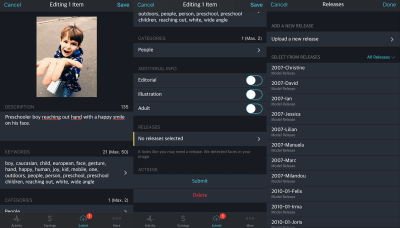Welcome! If you’re a photographer or designer looking to sell your images on Shutterstock, understanding how their review process works is essential. Shutterstock aims to maintain high-quality, professional content for its vast marketplace, so every image goes through a careful review before it goes live. This process can seem a bit mysterious at first, but once you know what to expect, it becomes much easier to prepare your submissions and increase your chances of approval. In this post, we’ll walk through how
Steps Involved in Shutterstock’s Image Review

Getting your images approved by Shutterstock involves a few key steps, each designed to ensure that the content meets their quality and legal standards. Here’s a breakdown of what happens behind the scenes:
1. Submission of Your Image
First things first, you upload your image through the Shutterstock Contributor portal. Make sure your files are high-resolution, properly tagged, and meet their technical specifications. Adding relevant keywords and a clear description helps reviewers understand the context and content of your image, which can speed up the review process.
2. Automated Screening
Once your image is uploaded, it goes through an automated screening process. This system checks for technical quality issues such as resolution, focus, exposure, and noise. It also scans for common copyright violations or inappropriate content. If your image passes this initial check, it moves on to human review; if not, you’ll receive feedback to make necessary adjustments.
3. Human Review
After the automated screening, trained Shutterstock reviewers evaluate your image manually. They look at several factors:
- Quality: Is the image sharp, correctly exposed, and free of distractions?
- Composition: Does it have a balanced, appealing layout?
- Content: Is the subject appropriate and clear? Are there any recognizable people or trademarks that need model or property releases?
- Legal considerations: Does the image respect copyright laws? Are there any sensitive or restricted content issues?
This step is crucial because human judgment ensures that only high-quality, compliant images make it onto the platform.
4. Feedback and Decision
After review, you’ll receive one of the following outcomes:
- Approved: Your image is accepted, and it goes live on Shutterstock!
- Rejected: The image doesn’t meet Shutterstock’s standards. You’ll get specific feedback, and you can choose to revise and resubmit.
- Needs Edits: Minor adjustments are required, such as cropping or retouching, before approval.
Most contributors find that understanding each step and adhering to Shutterstock’s guidelines greatly improves their chances of success. Remember, patience and attention to detail are key. Keep practicing, learn from feedback, and soon you’ll be submitting images that get approved more often than not!
Common Reasons for Image Rejection and How to Avoid Them

Getting your images approved on Shutterstock can sometimes feel like navigating a tricky maze. Even talented photographers and designers face rejection, but understanding the common pitfalls can make all the difference. Let’s dive into the most frequent reasons images get rejected and how you can steer clear of them.
Blurry or Poor-Quality Images
One of the biggest no-no’s is submitting images that are blurry, pixelated, or lack sharpness. Shutterstock is all about high-quality visuals that look professional and crisp. To avoid this:
- Always shoot in the highest resolution possible.
- Use a good camera and proper focusing techniques.
- Check your images for noise or compression artifacts before uploading.
Incorrect or Missing Model and Property Releases
If your images feature recognizable people or private property, Shutterstock requires proper releases. Without them, your images will be rejected. To prevent this:
- Obtain signed model releases from recognizable individuals.
- Secure property releases for private locations or branded items.
- Keep digital copies of releases ready for submission if needed.
Inappropriate or Over-Edited Content
Images that look overly manipulated or contain inappropriate content are often rejected. Keep edits natural and avoid heavy filters. Tips include:
- Maintain realistic colors and lighting.
- Avoid excessive retouching unless it enhances the image naturally.
- Ensure content is appropriate for a broad audience.
Low-Quality Composition or Cluttered Subjects
Shutterstock favors clean, well-composed images. Cluttered scenes or poor framing can hurt your chances. To improve composition:
- Use the rule of thirds for balanced framing.
- Remove distracting elements from the background.
- Focus on a clear subject that tells a story or conveys a message.
Copyright Violations and Infringements
Never upload images that infringe on someone else’s intellectual property. This includes copyrighted artwork, logos, or branded products without permission. Always:
- Create original content or ensure you have licensing rights.
- Avoid including copyrighted logos or trademarks unless you have permission.
- Research to confirm your image doesn’t unintentionally copy someone else’s work.
Best Practices to Ensure Your Images Pass Shutterstock Review
While avoiding common pitfalls is key, there are proactive steps you can take to make sure your images sail smoothly through the review process. Here are some tried-and-true best practices:
Follow Technical Specifications
Shutterstock has specific guidelines regarding resolution, file size, and format. Make sure to:
| Aspect | Details |
|---|---|
| Resolution | At least 4 megapixels (e.g., 4000 pixels on the long side) |
| File Format | JPEG for photos; PNG for graphics with transparency |
| Color Profile | sRGB color space |
| File Size | Maximum 50MB for images |
Adhering to these ensures your files meet technical standards and reduces rejection risk.
Focus on Originality and Creativity
Unique, eye-catching images stand out. Think about:
- Capturing authentic moments or perspectives.
- Using interesting compositions or lighting.
- Providing fresh takes on common themes.
Ensure Proper Model and Property Releases
As mentioned earlier, releases are crucial. Keep digital copies organized for quick submission. Remember:
- Releases should be signed and dated.
- Ensure they cover all intended uses.
Pay Attention to Details and Consistency
Small details matter. Double-check:
- That there are no watermarks, logos, or branding elements.
- The image doesn’t contain any visible copyright infringements.
- The overall quality is high and free of technical flaws.
Use Keywords Wisely
Proper tagging helps reviewers understand your image’s content. Use relevant, specific keywords that describe the subject, mood, and context. Avoid keyword spamming or misleading tags.
Review Shutterstock’s Guidelines Regularly
Standards evolve, so keep yourself updated by periodically reviewing Shutterstock’s contributor guidelines. Staying informed ensures your submissions meet current expectations and improves your success rate over time.
By following these best practices, you’ll not only maximize your chances of passing the review process but also build a reputable portfolio that attracts buyers. Happy uploading!
Tips for Improving Your Image Submission Success Rate
Getting your images accepted on Shutterstock can sometimes feel like navigating a tricky maze. But don’t worry—there are some tried-and-true strategies to boost your chances of approval. Whether you’re just starting out or looking to refine your approach, these tips can help you stand out and meet Shutterstock’s standards.
First things first: focus on quality over quantity. Shutterstock values images that are sharp, well-composed, and free of technical flaws. Invest in a good camera or smartphone with high-resolution capabilities, and learn basic photography skills like proper lighting and framing. Remember, a clear, professional-looking photo is much more likely to be accepted than a blurry or poorly lit one.
Next, pay close attention to image composition. Use the rule of thirds, keep horizons straight, and avoid cluttered backgrounds. Clean, simple compositions tend to perform better, especially for commercial use.
Another key tip is to ensure your images are relevant and in demand. Browse Shutterstock’s popular categories and keyword trends to understand what buyers are looking for. Adding images that align with current trends or evergreen themes like business, lifestyle, or technology can increase your chances of acceptance and sales.
When submitting, don’t forget about metadata. Use accurate, descriptive titles and keyword tags. Think about what someone would search for if they needed your image. The more relevant your keywords, the easier it is for your image to be discovered.
Also, pay attention to technical specifications:
- Image resolution should be high (usually at least 4 megapixels).
- Avoid images with watermarks, logos, or branding.
- Make sure your file format is accepted (JPEG for images).
- Remove any embedded metadata that might be irrelevant or distracting.
Lastly, review Shutterstock’s content guidelines regularly. They have specific rules about what can and cannot be accepted, especially regarding model releases, property releases, and intellectual property rights. Ensuring compliance from the start saves you time and increases your acceptance rate.
Remember, persistence is key. Don’t get discouraged by rejections—use them as learning opportunities. Keep refining your skills, stay updated on trends, and you’ll see your success rate improve over time!
Conclusion and Final Advice for Contributors
Contributing to Shutterstock can be an exciting and rewarding experience—if you understand how the review process works and how to prepare your images accordingly. Remember, Shutterstock’s reviewers are looking for high-quality, relevant, and technically sound images that meet their strict standards. By paying attention to detail, staying current with trends, and continuously improving your skills, you can increase your chances of approval and boost your sales.
My final advice? Stay consistent and patient. Success on stock photography platforms often comes from steady effort over time. Keep submitting, learn from each rejection, and don’t be afraid to experiment with different styles or subjects. Over time, you’ll develop a portfolio that not only gets accepted more easily but also resonates with buyers.
Remember to:
- Maintain high technical quality in all your images.
- Use accurate and strategic keywords and descriptions.
- Stay informed about Shutterstock’s guidelines and industry trends.
- Be patient and persistent—success doesn’t happen overnight.
Ultimately, your dedication and attention to detail will pave the way for a successful contribution journey. Keep learning, keep creating, and enjoy the process of sharing your unique perspective with the world!


